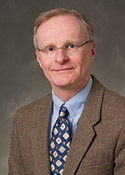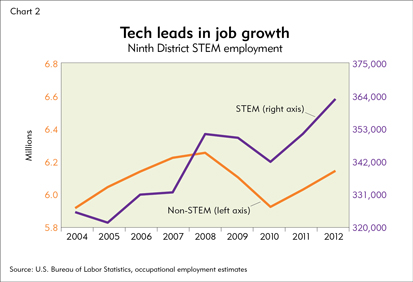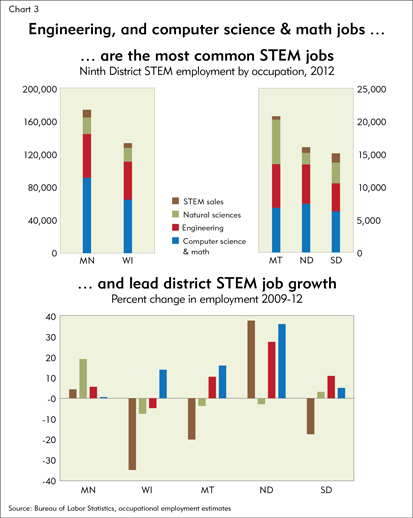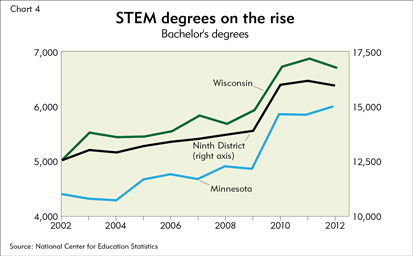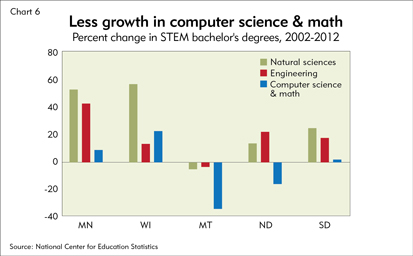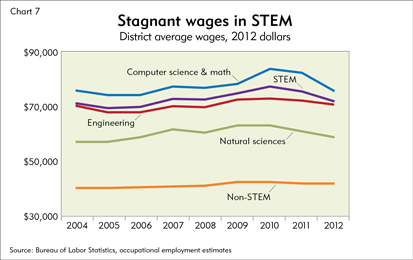Video: fedgazette writer Phil Davies on STEM education and careers
The Quick Take
Educators, employers and others worry that the higher education system is producing too few science, technology, engineering and mathematics (STEM) graduates, workers prized for their skills and contribution to innovation and economic growth. A fedgazette analysis of STEM education and employment in the Ninth District finds that numbers of STEM graduates and job openings are both rising. But the availability of these graduates and other workers to fill STEM vacancies varies markedly across STEM fields.
“STEM careers are in high demand and are an important part of our economy. ... I encourage students to consider getting a degree in a STEM field.”
—South Dakota First Lady Linda Daugaard
Like fresh vegetables and retirement savings, STEM education is something we can’t seem to get enough of. Nationwide and in the Ninth District, there’s a general concern that not enough college students are earning degrees in STEM (science, technology, engineering and mathematics) fields. Educators and state officials urge more students to enroll in STEM programs so they can earn high wages and contribute to innovation and increased productivity.
Employers also want more young people to earn STEM degrees, and some report difficulties hiring STEM graduates to fill entry-level positions and worry that the overall supply of STEM-educated workers is inadequate. “One of the major constraints of our business is getting enough talent,” said Todd Hauschildt, CEO of Swat Solutions, a Twin Cities software firm.
Worries about a STEM shortfall have prompted widespread efforts to boost the output of science and technology degree programs at U.S. universities and colleges. For example, Al Franken, a U.S. senator from Minnesota, has sponsored legislation that would establish a national corps of top STEM teachers to improve science and technology instruction in K-12 schools, with the idea of encouraging more college students to major in STEM fields.
In the district, South Dakota First Lady Linda Daugaard has actively promoted STEM secondary education in her state. And a number of district universities have established statewide STEM networks of educators, state officials, employers and other stakeholders to prime the STEM pump and increase the number of science and technology majors. (For more on public and private efforts to foster STEM education, see “Fixing the STEM pipeline.”)
Like those in many other parts of the country, employers in the district rely heavily upon graduates of universities and colleges in their home states to staff their operations. Homegrown graduates are more likely to take jobs in Minneapolis, Bismarck, N.D., and Mitchell, S.D.—and stay in those positions—than graduates from outside the region.
It’s impossible to say with certainty whether the district suffers from a deficiency of STEM graduates, as many STEM advocates fear. The supply of and demand for STEM graduates varies geographically and over time, and the STEM rubric covers many occupations, each with its own labor market dynamics. Also, some components of demand, such as replacements for workers who retire or quit their jobs, are difficult to measure.
Moreover, as with any good or service, market forces tend to work to equalize supply and demand. There’s evidence that demand for STEM workers has increased in an expanding regional economy, but the output of STEM graduates from higher education institutions in the district has also increased. In addition, wage trends suggest that overall demand for STEM graduates is being met.
However, the supply of STEM graduates relative to job opportunities in STEM occupations varies markedly across STEM fields. And there are signs of rising demand for STEM workers in some parts of the district and in certain STEM occupations. In Minnesota, for example, STEM job vacancies jumped last year, particularly in computer science and engineering.
Some employers have had to try harder to attract talented STEM graduates—raising wages, for instance, or offering internships to snag promising students while they’re still in school.
In coming years, demand for STEM graduates is likely to grow, and not just in traditional tech fields such as information technology, computers and scientific research. The pervasiveness of technology in today’s economy has led employers in an array of industries to value the aptitudes and skills that come with a STEM education.
STEM (ill) defined
STEM—science, technology, engineering and math—is a familiar acronym, widely used in government, academia and business to describe a set of fields of study in higher education, as well as a set of occupations that require STEM skills. But there’s no standard definition of a STEM degree or job. While fields such as computer programming, mechanical engineering and environmental science are generally considered STEM, there’s less consensus about fields such as medicine, architecture and science education.
The U.S. Department of Labor, for example, includes social scientists and health care workers in its definition of STEM occupations, while the U.S. Department of Commerce and the Minnesota Office of Higher Education exclude them.
For the purposes of this article, STEM degrees are those in engineering, math and the physical and life sciences (chemistry, biology, computer sciences, and so on) awarded at the two-year (associate) level and above.
STEM occupations are those typically requiring degrees in a STEM field, including agriculture-related disciplines such as soil, plant and animal sciences. The definition of STEM jobs used here encompasses managerial positions in STEM and workers such as laboratory technicians who support the work of STEM professionals.
Left out of the discussion and charts are health care workers, social scientists (such as psychologists and economists), and science and technology teachers.
The root of prosperity

For all the attention paid to STEM, a surprisingly small slice of jobs can be categorized as STEM—positions requiring scientific or technical expertise. (See sidebar for a discussion of how STEM occupations and degrees are defined.) Nationwide, only about 6 percent of workers are in science, technology, engineering and mathematics occupations. In district states, STEM as a proportion of the nonfarm workforce ranges from 4 percent in South Dakota to 7 percent in Minnesota.
But STEM’s minor presence in the workforce belies its outsize impact on the U.S. economy and the economies of states and local communities. New products and services born of technological advances (think the iPhone and cloud computing) increase the productivity of firms and workers, raising incomes and improving standards of living.
A 2013 study by the Brookings Institution found that U.S. metro areas with high patenting activity—a proxy for innovation—in fields such as computers, biotechnology and energy had higher productivity and lower unemployment than cities that generated fewer patents. The high-tech hubs of Minneapolis-St. Paul and Rochester, Minn., made Brookings’ top-20 list of high-patenting metros.
Innovation doesn’t happen without workers trained in STEM fields, observes University of Minnesota President Eric Kaler, a STEM graduate (Ph.D. in chemical engineering) himself. “These are people employed in high-tech companies; they’re people creating the inventions and products that are going to drive the Minnesota economy in the future,” he said. “The leverage you get from somebody who’s innovative and who applies science and technology is very important.”
Kaler noted that alumni of the university’s College of Science and Engineering have founded 2,600 Minnesota companies that generate about $46 billion in annual revenue and employ more than 175,000 people. Notable examples include Medtronic, Ceridian and Pentair.
STEM’s share of total employment may be small, but workers in STEM occupations enjoy higher pay and better employment prospects than non-STEM workers. STEM workers in occupations requiring a bachelor’s or advanced degreeearned 4 percent to 24 percent more than similarly educated non-STEM workers in district states, according to federal labor statistics (see Chart 1). Minnesota had the highest STEM pay among district states; in 2012, the median wage for STEM workers in the state topped $82,000, though that still trailed the national average.
Earnings of engineers, computer programmers and other STEM workers are on par with professional and managerial salaries in sectors such as health care, business and finance.
STEM jobs are also growing faster than the rest of the labor market. Like everybody else, STEM workers took their lumps during the recession; nationwide, a quarter-million STEM jobs disappeared from 2008 to 2010. Despite this pullback, STEM jobs grew at three times the rate of non-STEM employment from 2004 to 2012 (see Chart 2). Three years after the recession, the district had regained all of the STEM jobs it lost and more, while non-STEM employment still languished below 2008 levels.
In Minnesota—the district state with the most STEM workers due to well-established construction, computer software and medical technology industries—STEM employment grew 6 percent from 2010 to 2012, to about 180,000 workers. North Dakota’s STEM workforce is only one-tenth as large, but STEM employment grew 29 percent over the same period.
In most district states, engineering, and computer science and math, account for the bulk of STEM jobs, and those occupations have led post-recession growth in STEM employment (see Chart 3). In North Dakota, computer science and math employment has surged, driven by demand from computer software and health care firms in Fargo, Grand Forks and other cities in the Red River Valley.
Engineering employment has also increased sharply in North Dakota since the recession. “There’s a healthy demand for engineers right now” to work in the state’s oil and gas industry, said Wayne Biberdorf, a former energy industry engineer who sits on the advisory board of the petroleum engineering program at the University of North Dakota (UND).
Minnesota and South Dakota saw relatively small increases in computer science and math jobs from 2009 to 2012 because employment losses in the computer industry continued into 2010 before firms resumed hiring large numbers of workers.
Here come the graduates
A multitude of college science and technology programs across the Ninth District supply much of the labor for these STEM jobs. Firms value new graduates for their energy and the fresh ideas and skills they bring to the workplace, such as novel analytical techniques or the latest web development tools. The Brookings study found that metro areas with high patenting levels also had high shares of college graduates in STEM fields.
Roughly 200 institutions of higher learning confer STEM degrees in the district, and national education statistics show that their output has increased since the early 2000s. About one in five sheepskins awarded in the district is in a STEM field, and baccalaureate degrees account for about three-quarters of STEM degrees.
In Minnesota and Wisconsin, the district states with by far the largest number of STEM graduates, STEM bachelor’s degrees awarded rose after 2004, then surged after the recession (see Chart 4). In the Dakotas, awards of four-year STEM degrees also rose markedly after the recession. Only in Montana have degree awards declined over the past decade. On a per capita basis, the district beats the U.S. average in STEM degree production; in 2012, every district state awarded more STEM bachelor’s degrees per thousand people than the nation as a whole (see map).
However, production of STEM graduates varies considerably by field of study. In the nation, and in most district states (see Chart 5), higher education institutions produce more graduates with degrees in natural science—majors such as physics, chemistry and soil science—than degree holders in either engineering or math-related fields such as statistics and computer science. And every district state has seen larger increases of graduates in natural science and engineering than in computer science and math. Growth in computer science and math has lagged particularly at the bachelor’s degree level (see Chart 6).
In Montana, awards of four-year STEM degrees fell across the board from 2002 to 2012, but fell by over 30 percent in computer science and math. Enrollment in computer science programs fell nationwide in the early 2000s, after the high-tech stock bubble burst and Internet firms started laying off workers.
“It’s not just a Montana thing,” said John Paxton, head of the computer science department at Montana State University (MSU). “Those two things in conjunction produced an environment where you lost half of the people studying computer sciences from 2001 to about 2009.”
At MSU, which produces most of the state’s computer science graduates, bachelor’s degrees fell from 47 in 2004 to just 20 in 2013. At other district schools, computer science enrollments and graduations have bounced back since the recession, but not enough to make up lost ground.
STEM anxiety
The nationwide falloff in computer science graduates has fed a persistent concern among educators and employers—often echoed by politicians—that the overall supply of new STEM graduates in the district is inadequate to meet current and future demand from employers.
Studies by organizations such as the National Academy of Sciences, the Council on Competitiveness and the Association of American Universities have argued that a shortage of science and engineering graduates threatens the country’s capacity to innovate and compete in the global economy. An often-cited statistic: In 2009, the United States ranked 27th among developed nations in the proportion of college students receiving undergraduate degrees in science or engineering.
Such statistics stir anxiety about the state of STEM in the district. A March presentation by North Dakota university and economic development officials at a small business innovations summit in Fargo talked about “The STEM Dilemma,” asserting that “the demand for STEM professionals in the U.S. outpaces supply,” and “too few university students are graduating in STEM fields.”
In the state, “there’s a general sense that there’s a shortfall, that there aren’t enough STEM graduates” from state institutions entering the workforce, said Wayne Kutzer, director of the state Department of Career and Technical Education, the lead agency for STEM education in North Dakota.
By many measures, demand is high for homegrown STEM graduates. Many employers, especially smaller firms or those based outside metro areas, say they concentrate their recruiting efforts in their own backyards. College graduates from the same state or adjacent states are seen as not only more likely to join the firm, but also more predisposed to stay.
“We’ve found out as a small company that it’s really hard to recruit somebody from another geography,” said Hauschildt of Swat Solutions. “It’s hard to get people to see Minnesota as a destination unless they have some sort of family tie to Minnesota.” Roughly 60 percent of the firm’s employees are graduates of the University of Minnesota, the University of Wisconsin and other schools in the Upper Midwest.
At Bartlett & West, an engineering firm that does general construction and pipeline projects in the North Dakota oilfields, 90 percent of the engineers in the Bismarck office are graduates of engineering schools in either the state or neighboring Montana. “We haven’t had a lot of people from out of [the region] come to Bismarck,” said Jame Todd, a principal with the firm. “The winters are pretty harsh here.”
Despite concerns about a shortfall of STEM graduates, there’s little evidence that STEM jobs in the district are going begging for lack of science and technology graduates to fill them. But demand for STEM graduates is higher in some district states than in others. And at least in Minnesota and North Dakota, STEM fields differ greatly in the ratio of graduates to job vacancies. The types of STEM degrees students pursue have a strong bearing on the level of job competition they face upon graduation.

Why pay more?
Gauging demand for STEM graduates in the district is tricky because homegrown college graduates aren’t the only fish in the labor pool. In most STEM occupations, older workers, including those who lost their jobs during the recession, are available to fill job openings. To some extent, employers can hire STEM graduates from other parts of the country to fill entry-level positions. And not all STEM positions require a bachelor’s degree or even a two-year degree in a STEM field.
One way to look at demand for STEM graduates in the district is to examine wage trends. Basic economics dictates that a tighter labor supply puts upward pressure on wages as employers compete for scarce workers.
In fact, STEM wages nationwide haven’t risen much since the recession—leading some analysts to conclude that the country has more than a sufficient supply of STEM workers. Wages have also barely budged in the district. Adjusted for inflation, the average STEM wage in the district actually fell slightly from 2008 to 2012, while wages for non-STEM workers rose about 1 percent (see Chart 7). Even in fast-growing STEM occupations such as computer science, real wages stayed flat or declined in a recovering regional economy.
Similar wage patterns are evident in individual district states, including North Dakota, which has experienced torrid economic growth, partly due to the oil boom in western counties. Stagnant STEM wages suggest that employer demand is being met by new STEM graduates of district institutions, together with other STEM workers.
Thousands of STEM workers in the district were laid off during the recession. From 2008 to 2010, Wisconsin lost almost 4,000 engineering jobs, and in Minnesota, computer and math employment shrank by 1,100 jobs over the same period. Today, job openings continue to be filled by these experienced workers and other job seekers, including recent college graduates who have moved to the region from elsewhere in the country.
North Dakota’s labor vacuum—the state unemployment rate was less than 3 percent in January—has drawn workers from across the country. From 2010 to 2012, the state added on average about 1,900 STEM jobs annually, more than twice the number of STEM degrees awarded in the state each year. Thus, the state is almost certainly a net importer of STEM graduates.
“North Dakota needs workers everywhere, not just in STEM,” said Beth Zander, director of Workforce Development at the state Department of Commerce. “If we educated and retained all of our youth, we still wouldn’t have enough workers for the jobs that we have and will see. So we also look to talent outside the state.”
In computer hardware and information technology, many district firms have hired foreign computer science graduates who enter the U.S. workforce on H-1Bs or other types of visas (see “Does foreign labor hurt U.S.-born workers?” in the October 2013 fedgazette).
However, wage trends for STEM graduates aren’t uniformly flat. Some STEM occupations have seen substantial wage gains, indicating increased pressure on supply; for example, the U.S. average annual wage for petroleum engineers rose 9 percent in constant dollars from 2010 to 2012—five times the increase for all occupations.
STEM help wanted
Job openings provide another perspective on supply and demand for STEM graduates. Job vacancies capture total demand for workers in a particular occupation, including replacement workers and jobs that are waiting to be filled. And while job openings offer just a snapshot of labor market conditions at one point in time, they’re usually more up to date than aggregate job statistics and so often can capture recent labor market trends.
The Minnesota Department of Employment and Economic Development (DEED) conducts a semiannual survey of employers to determine job vacancy levels in over 20 occupational groups. In the most recent survey, in the spring of 2013, employers reported over 5,300 openings in computer science and math, engineering and natural sciences occupations. In comparison, about 7,500 STEM graduates with bachelor’s and advanced degrees entered the job market in 2012 (statewide graduation data were unavailable for 2013). The inference—assuming that many of those graduates sought jobs close to home—is that employers could take their pick of Minnesota STEM graduates last year.
However, a more nuanced picture emerges when the balance of STEM vacancies versus graduates is viewed in terms of different STEM fields.
The survey showed higher demand for engineers, and computer science and math professionals, than for natural science workers. The job vacancy rate—openings as a percentage of all jobs in a given occupation—was over 4 percent for computer science and math workers, and over 5 percent for engineers. The rates for physical and life scientists were less than 3 percent, lower than the rate for all occupations.
The survey also indicated tighter supplies of computer science and math workers than in previous years. Computer science and math employers had over 3,400 openings statewide—four times the number of such openings in 2009, although still short of a prerecession peak of over 4,000. Vacancies in that occupational group were double the number of Minnesota college graduates with bachelor’s or advanced degrees in computer science or math who entered the job market in 2012 (statewide graduation data were unavailable for 2013).
Computer software firms in the state are feeling the pinch, said Margaret Anderson Kelliher, president of the Minnesota High Tech Association. “Distinctly in the computer science world, there is a numbers deficit. It’s a situation right now where there’s almost a negative unemployment rate for computer science, especially in the Twin Cities metropolitan area.”
Hauschildt of Swat Solutions can attest to a computer sciences hiring crunch in the metro area. The St. Louis Park firm, which helps software manufacturers ensure quality, has grown rapidly to about 75 employees since the recession but has struggled to fill new positions, including entry-level jobs suitable for recent graduates with bachelor’s degrees. “It’s hard to find software engineers,” he said. “These graduates are fielding multiple offers and taking their pick of them.”
In contrast, the DEED job vacancy survey suggests that employers of engineers had less trouble filling job vacancies than computer science and math firms. Demand for engineers in Minnesota has also increased in recent years; in 2013, engineering job openings increased 42 percent from the year before, to over 1,600—the highest number of vacancies in this sector in the past decade. But that was less than the 2,050 engineering degrees at the bachelor’s level and above awarded by Minnesota institutions in 2012.
Employers of natural science graduates appeared to be in the best position of all in the survey; there were 313 openings in the physical and life sciences—a fraction of the almost 3,800 natural sciences graduates from state institutions the year before. In Minnesota, as in other district states, these fields are popular degree choices. But since the recession, state employment in the natural sciences has grown less than STEM jobs overall. Job openings in the natural sciences increased only about 20 percent from 2012 to 2013.
North Dakota Job Service also tracks job openings, although its data are limited to online job postings. The monthly average of STEM openings in the second quarter of 2013 actually fell year over year, but the ratio of openings to college graduates in different occupational groups was similar to those in the Minnesota survey. Computer science and math openings exceeded the number of bachelor’s-and-above graduates from North Dakota colleges and universities in 2012. In engineering, there were slightly more STEM grads than openings, while in physical and life sciences, graduates outnumbered vacancies by more than three to one.
From the lab to Wall Street
Yet another way to measure demand for STEM graduates is to view the labor market through a wider lens. Some analysts have suggested that employer demand for STEM grads is greater than that indicated by a straightforward STEM-grad-to-STEM-job accounting because many STEM graduates are getting hired for non-STEM positions.
Employers in a range of industry sectors—finance, health care, manufacturing—value STEM knowledge and skills in their workforces. And some holders of science and technology degrees are attracted to non-STEM occupations because they pay higher salaries or are more personally satisfying than traditional STEM jobs.
“A STEM education is a very good preparation for a productive career in any number of fields,” observed Kaler of the University of Minnesota. “There are a lot of mathematicians and physicists who wind up on Wall Street, doing quantitative economics. They may even wind up at the Federal Reserve.”
If significant numbers of STEM graduates are finding jobs in non-STEM occupations, the supply of graduates to fill engineering, R&D and other types of STEM jobs is less than the annual sum of STEM degrees awarded by colleges and universities.
Nationally, it does appear that STEM graduates are being pulled into non-STEM fields. In 2009, almost two-thirds of 9.3 million U.S. workers with a STEM bachelor’s degree or higher worked in a non-STEM job, according to a study by the U.S. Department of Commerce.
Degree holders in the life and physical sciences are most likely to have non-STEM jobs. A 2011 study by the Center on Education and the Workforce at Georgetown University found that only 35 percent of physical scientists with bachelor’s degrees were working in a STEM field immediately after graduation. Many natural science baccalaureates land managerial jobs or continue their education to become doctors or college professors.
Determining the extent to which STEM graduates from district institutions divert into non-STEM careers is beyond the scope of this article. Comprehensive, state-level employment statistics track workers only by occupation and industry, not by the type of degree they hold. Another unknown, both in the district and across the country, is the proportion of science and technology graduates who are working in non-STEM fields involuntarily—that is, because they can’t get a job related to their field of study.
Creative recruiting
Imbalances or apparent misalignments of supply and demand for some types of STEM graduates don’t necessarily mean that employers can’t find the workers they need. Even in occupations or areas of the district with seemingly tight supplies of STEM graduates, there are those alternative sources of labor—new college graduates from outside the district and the unemployed from near and far.
But the uneven distribution of STEM graduates relative to job opportunities in the district does mean that some employers have to go to greater lengths to garner their share of the annual harvest of homegrown college graduates.
Since the recession, Swat Solutions has raised wages about 20 percent for entry-level software engineers and programmers and sweetened its benefits package. And the firm pulls out all the recruiting stops to compete with the likes of Thomson Reuters, 3M and Google, attending job fairs at the University of Minnesota, offering summer internships and encouraging employees to visit Twin Cities colleges to talk about the quality assurance industry and career opportunities at the firm.
“We’re a small organization, competing for the same limited pool of graduates,” Hauschildt said. “So we have to be a little more creative ... to start establishing our name as a good place to be for STEM graduates.”
Bartlett & West also hires interns; last summer, about a dozen engineering students, mostly from North Dakota State University, worked in the Bismarck office, assisting with field surveys, contractor paperwork, engineering reports and other everyday tasks. Todd said that, because of the intense competition for engineering talent in western North Dakota, the quality of engineering students applying to the firm has dropped over the past couple of years. Internships are a way to home in on the best students before they graduate and get snapped up by other employers.
“You can kind of get an idea of who’s the cream of the crop,” Todd said. “We’re able to train these people early on and find out more about them, so by the time they graduate, then we’ve got a much higher quality candidate.”
Innovative Systems, a Mitchell, S.D., provider of software and hardware for the telecommunications industry, goes one step further in its internship program. For several years, the firm has paid an instructor at the South Dakota School of Mines and Technology in Rapid City to supervise interns who work in a satellite office on campus, writing software for Innovative. Each year the firm hires several of these programming apprentices. The arrangement allows the instructor to spend part of the day teaching classes in leading-edge communications software at the School of Mines.
STEM for all
In coming years, demand for STEM graduates from district higher education institutions likely will increase. More computer science, math and engineering graduates will be needed to work in growing industries such as mobile communications, data analytics, medical devices, and oil and gas extraction. And technological advances have created STEM occupations that didn’t exist a few years ago—like drone imagery analyst.
Last fall, Northland Community and Technical College in Thief River Falls, Minn., began offering a one-year certificate in imagery analysis for unmanned aircraft systems. Graduates of the program may get jobs analyzing aerial video just to the west in North Dakota, which has been designated a test site for new commercial uses of drones by the Federal Aviation Administration.
A number of national studies have projected STEM jobs as a share of total employment increasing over the next decade. A caveat applies to job projections: Labor markets are dynamic, with constant shifts in supply and demand due to wage changes, industry slowdowns and other factors. But a 2010 analysis by the Georgetown University researchers estimated that, from a base year of 2008, total U.S. employment would increase 10 percent through 2018. But the number of STEM jobs was projected to grow by 17 percent during that time.
In district states, many STEM occupations are expected to see strong growth over the next seven years, according to future growth estimates for different occupations prepared by state labor departments.
In North Dakota, for example, jobs for civil engineers were projected to increase by one-third from 2010 to 2020. In Montana, a 50 percent rise in employment for developers of system software was projected over that period. And in Minnesota, the ranks of biomedical engineers were expected to swell by 66 percent.
Demand is also likely to rise for STEM graduates in non-STEM fields because of the increasingly technical nature of the U.S. and global economy.
Sharon Vestal, director of a program at South Dakota State University to enhance rural STEM education, sees modern farming as a burgeoning STEM occupation: “Frankly, agriculture is becoming more of a science. The equipment is run by computers, and [farmers] use GPS mapping to plant and apply fertilizer. In order for South Dakota to stay competitive in terms of agriculture, we need more people who are educated in soil science and plant science and GPS and all those things.”
If expectations for job growth within and outside core STEM occupations come to pass, district universities and colleges will likely need to prepare for more students, especially in computer science and engineering. Recent enrollment trends since the recession indicate that young people are already responding to market signals.
The University of Minnesota’s College of Science and Engineering has seen a 13 percent rise in undergraduate enrollment since 2009 due to revived student interest in—and higher employer demand for—degrees in mathematics, civil engineering and other STEM degrees. To accommodate this growth, the university’s Twin Cities campus plans to hire 100 new STEM faculty members this year, Kaler said.
At UND’s College of Engineering & Mines, enrollment has increased over 80 percent since 2007, when the oil boom took hold in North Dakota. Biberdorf says universities in the state “grasped onto the need rather quickly” to produce more engineers in a number of subfields—civil, mechanical, petroleum—to meet demand from oil companies, construction firms and other employers in the Bakken oilfields. In 2010, UND launched the state’s first petroleum engineering degree program. Seven students enrolled the first year; this spring, 211 students are in the program, which has suffered some growing pains.
In Montana, MSU’s computer science department is poised to sharply increase the size of its spring graduating class due to big enrollment gains over the past five years. As of last fall, the number of bachelor’s degree candidates had rebounded to 281, almost twice the number of students enrolled in 2007.
“The good news is that ... we’re about to double the number of our graduates, even compared to a year ago,” Paxton said. He added that “it’s exciting ... and it’s also scary” because of the added teaching burden being borne by computer science faculty. Despite the enrollment surge, the department still has the same number of instructors it employed in 2007.
Research assistants Bijie Ren and Dulguun Batbold contributed to this article.
Related content

